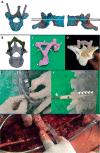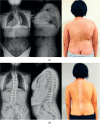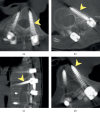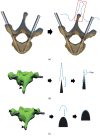The Accuracy of 3D Printing Assistance in the Spinal Deformity Surgery
- PMID: 31828123
- PMCID: PMC6885147
- DOI: 10.1155/2019/7196528
The Accuracy of 3D Printing Assistance in the Spinal Deformity Surgery
Abstract
Background: The pedicle screw is one of the main tools used in spinal deformity correction surgery. Robotic and navigated surgeries are usually used, and they provide superior accuracy in pedicle screw placement than free-hand and fluoroscopy-guided techniques. However, their high cost and space limitation are problematic. We provide a new solution using 3D printing technology to facilitate spinal deformity surgery.
Methods: A workflow was developed to assist spinal deformity surgery using 3D printing technology. The trajectory and profile of pedicle screws were determined on the image system by the surgical team. The engineering team designed drill templates based on the bony surface anatomy and the trajectory of pedicle screws. Their effectiveness and safety were evaluated during a preoperative simulation surgery. The surgery consisted in making a pilot hole through the drill template on a computed tomography- (CT-) based, full-scale 3D spine model for every planned segment. Somatosensory evoke potential (SSEP) and motor evoke potential (MEP) were used for intraoperative neurophysiological monitoring. Postoperative CT was obtained 6 months after the correction surgery to confirm the screw accuracy.
Results: From July 2015 to November 2016, we performed 10 spinal deformity surgeries with 3D printing technology assistance. In total, 173 pedicle screws were implanted using drill templates. No notable change in SSEP and MEP or neurologic deficit was noted. Based on postoperative CT scans, the acceptable rate was 97.1% (168/173). We recorded twelve pedicle screws with medial breach, six with lateral breach, and five with inferior breach. Medial breach (12/23) was the main type of penetration. Lateral breach occurred mostly in the concave side (5/6). Most penetrations occurred above the T8 level (69.6%, 16/23).
Conclusion: 3D printing technology provides an effective alternative for spinal deformity surgery when expensive medical equipment, such as intraoperative navigation and robotic systems, is unavailable.
Copyright © 2019 Po-Chen Chen et al.
Conflict of interest statement
The authors declare that they have no conflicts of interest.
Figures




References
-
- O’Brien M. F., Lenke L. G., Mardjetko S., et al. Pedicle morphology in thoracic adolescent idiopathic scoliosis: is pedicle fixation an anatomically viable technique? Spine. 2000;25(18):2285–2293. - PubMed
-
- Kim Y. J., Lenke L. G., Cheh G., Riew K. D. Evaluation of pedicle screw placement in the deformed spine using intraoperative plain radiographs: a comparison with computerized tomography. Spine. 2005;30(18):2084–2088. doi: 10.1097/01.brs.0000178818.92105.ec. - DOI - PubMed
-
- Gelalis I. D., Paschos N. K., Pakos E. E., et al. Accuracy of pedicle screw placement: a systematic review of prospective in vivo studies comparing free hand, fluoroscopy guidance and navigation techniques. European Spine Journal. 2012;21(2):247–255. doi: 10.1007/s00586-011-2011-3. - DOI - PMC - PubMed
MeSH terms
LinkOut - more resources
Full Text Sources
Medical

